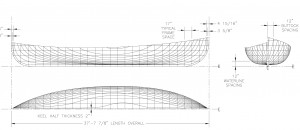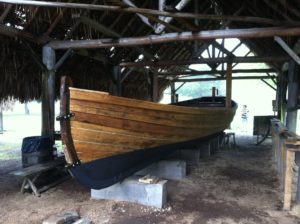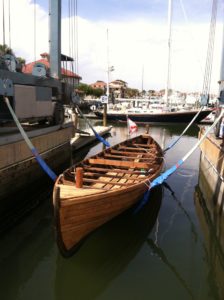 The chalupa in her slings after launch at the Camachee Cove Marina March 11, 2015
The chalupa in her slings after launch at the Camachee Cove Marina March 11, 2015
The chalupa replica project hit a major mile stone this past Saturday, March 28, when it rowed out of Hospital Creek for the first time into Matanzas Bay. The craft was blessed and christened the San Agustín six days earlier on March 22nd at her home port located at the Fountain of Youth Archaeological Park. This grass roots collaborative community project is being carried out by the St. Augustine Maritime Heritage Foundation in partnership with the Fountain of Youth Archaeological Park and the St. Augustine Lighthouse & Museum.
The St. Augustine Lighthouse & Museum contributed the research that has made the project possible. In 2007 the Lighthouse Archaeological Maritime Program (LAMP) of the St. Augustine Lighthouse & Museum received a special category grant from the Division of Historical Resources of the Florida Department of State. The grant funded archaeological and historical research that focused on St. Augustine’s maritime past as well as the purchase of diving and remote sensing equipment that allowed the LAMP program to develop into what it has become today. One of the line items in that grant was a research trip to the Archives of the Indies in Seville Spain. That trip in 2008 proved critical to what would become the St. Augustine Maritime Heritage Foundation’s chalupa replica project.
This research led to the discovery of a Spanish document from the year 1597 that described a chalupa built in St. Augustine for the use of the presidio, or military establishment. The description included the fact that the craft had ten oars, two masts with sails as well as a rudder and associated hardware. This information was combined with archaeological data from Red Bay in Labrador, Canada. There the Spanish Basques, close neighbors to the port of Avilés on the north coast of Spain, had a booming whaling business. This business was well established by 1565 when Pedro Menéndez founded St. Augustine. That very same year a whaling galleon called the San Juan was wrecked in Red Bay and during the wrecking event she crushed her ship’s boat, a six oared, 26 foot, chalupa.
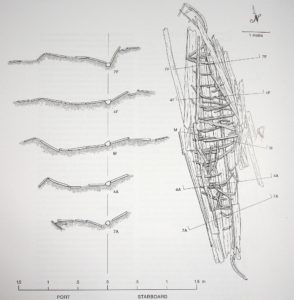 Archaeological site map of the Red Bay chalupa courtesy of Parks Canada
Archaeological site map of the Red Bay chalupa courtesy of Parks Canada
The waters of Labrador are very cold and an estimated 80% of the chalupa was preserved. This well preserved example contributed all the joining and fastening information necessary for the construction of an authentic replica. The well preserved remains were also sufficient to generate a set of lines drawings that documented the shape of the hull. We had all the ingredients for a successful replica project. Four rowing benches were added to the Red Bay chalupa and the lines drawings modified and projected for the larger, ten oared, St. Augustine chalupa.
The lines of the San Agustín as drawn by Ed Glowacki of Glowacki Engineering
The vision required the replica be built in town so that the funds expended in the endeavor would be of financial benefit to the local community. Most importantly of all however, was to continue to recover the traditional art of boat and ship carpentry that had once been a hall mark of St. Augustine’s waterfront dating back to the city’s founding. A concerted effort to recover and pass on these skills has been ongoing at the St. Augustine Lighthouse & Museum since the founding of the boat works exhibit there in 2007. This replica project, in many ways, is an outgrowth of that program.
Experimental archaeology was also a focus of the project. How did the boat carpenters of the 16th century frame, plank, and fasten their vessels, and what local timber resources would they have used? Nautical archaeology has contributed a great deal of knowledge on that subject but how they actually built it physically could only be ascertained by the process of construction itself.
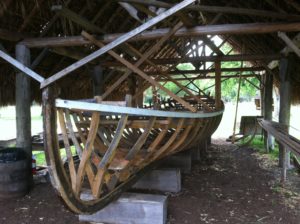 The chalupa fully framed during construction in the boathouse at the Fountain of Youth Archaeological Park
The chalupa fully framed during construction in the boathouse at the Fountain of Youth Archaeological Park
The finished chalupa on March 10th before placing on a trailer to take her to be launched at Camachee Cove Marina
The San Agustín is 38’ 1” long and has benches for ten rowers. The first sea trials show that the rudder is very effective in turning the craft which draws approximately 1’ 6” of water. This fact makes it an ideal craft for St. Augustine permitting it to operate in confined waters on a falling tide. The crew has been training since January 29th on a smaller 23’ rowing craft in order to acquire the necessary rowing skills to spin the boat, turn the boat to port and starboard while under way, stop the boat, back the boat, and to increase and decrease the rowing tempo while underway. All these skills are necessary in order to competently and safely operate the San Agustín.
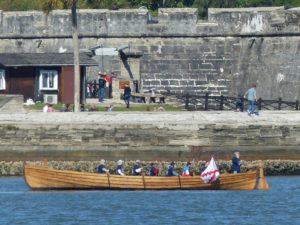 The chalupa in front of the Castillo de San Marcos on her first day of sea trials (photo courtesy of Stephen Grey)
The chalupa in front of the Castillo de San Marcos on her first day of sea trials (photo courtesy of Stephen Grey)
The next phase of this project calls for building and installing San Agustín’s sailing rig. The chalupa was a craft that could be either rowed or sailed. Often in ports for local work the chalupa would operate as the San Agustín currently does with none of the sailing rig installed. They would simply travel as a rowed craft carrying their cargoes of supplies and people from one point to another. This is the configuration we are currently experimenting with. Trip by trip we will improve our rowing capabilities and extend the range of the San Agustín on our inland waters. And, as is the case with all experimental archaeology, we will find the most efficient way of doing things and use that knowledge to improve our understanding of 16th century maritime St. Augustine.
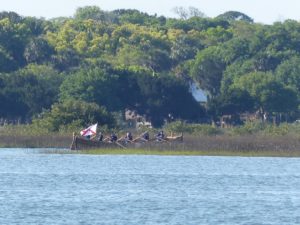 Heading back into Hospital Creek after the second day of sea trials (photo courtesy of Cynthia Grey)
Heading back into Hospital Creek after the second day of sea trials (photo courtesy of Cynthia Grey)
Dr. Sam Turner joined the St. Augustine Lighthouse & Museum in 2006. Dr. Turner earned his master’s in nautical archaeology at Texas A&M University and received his Ph.D. in Spanish and Spanish American studies from King’s College of the University of London.


